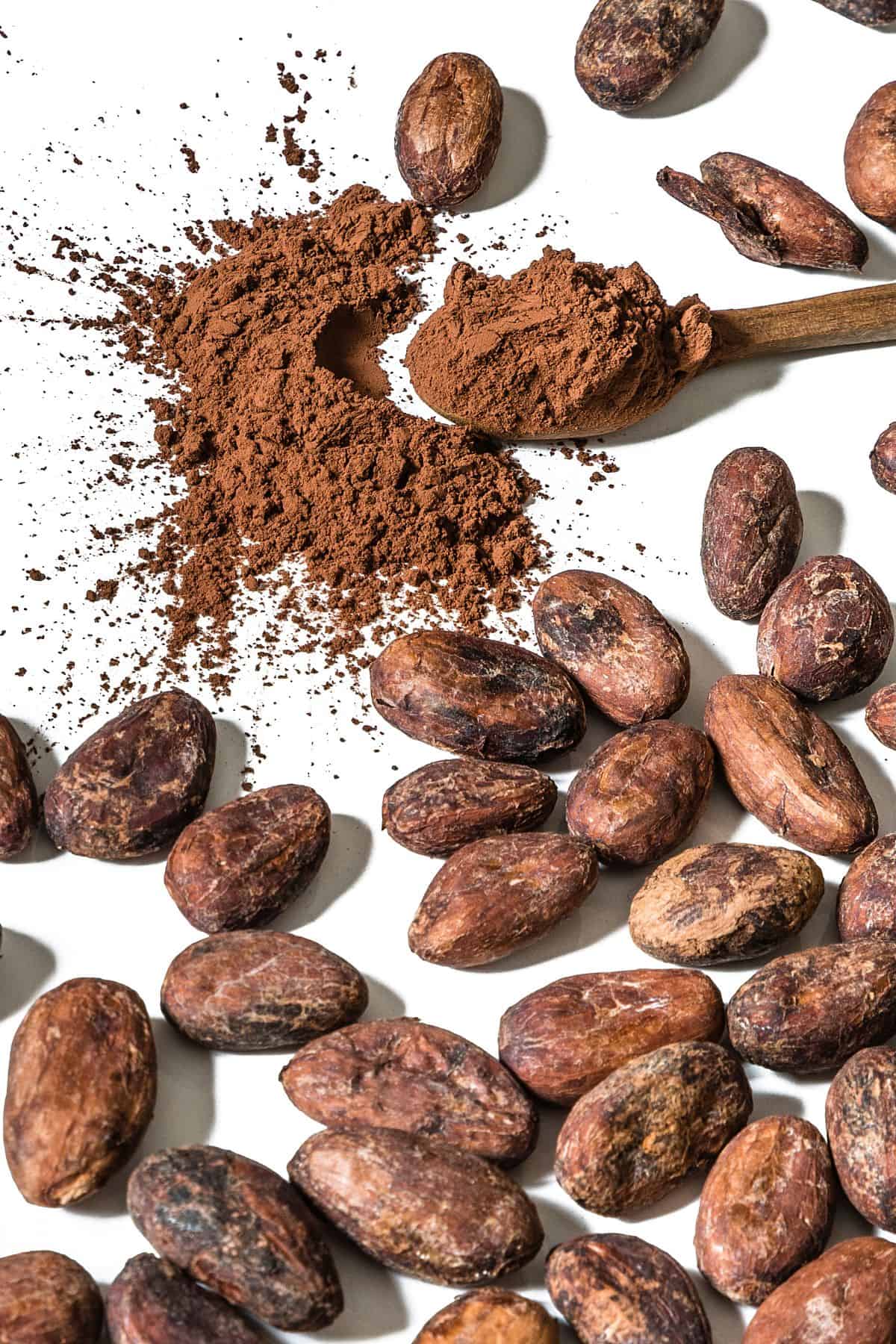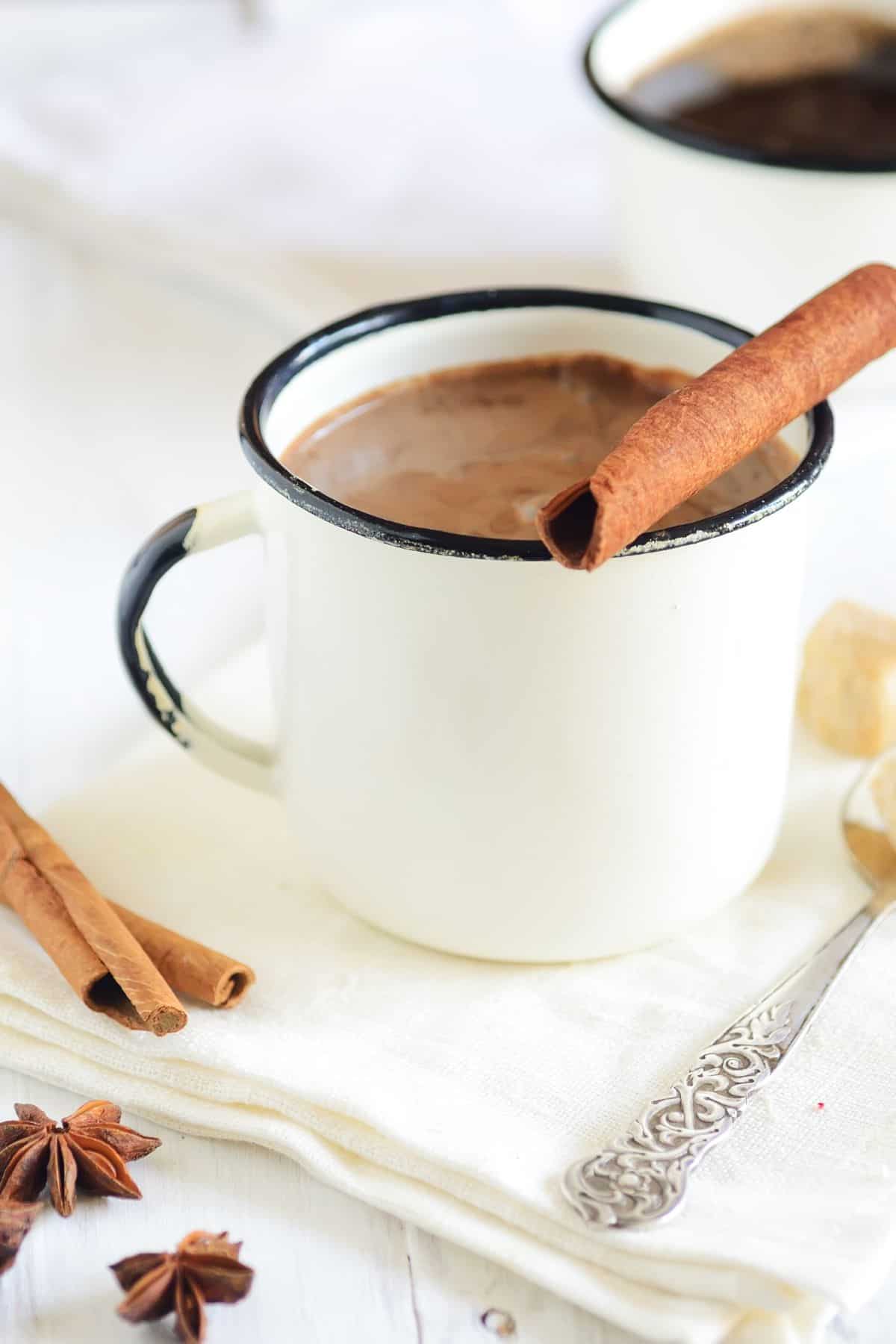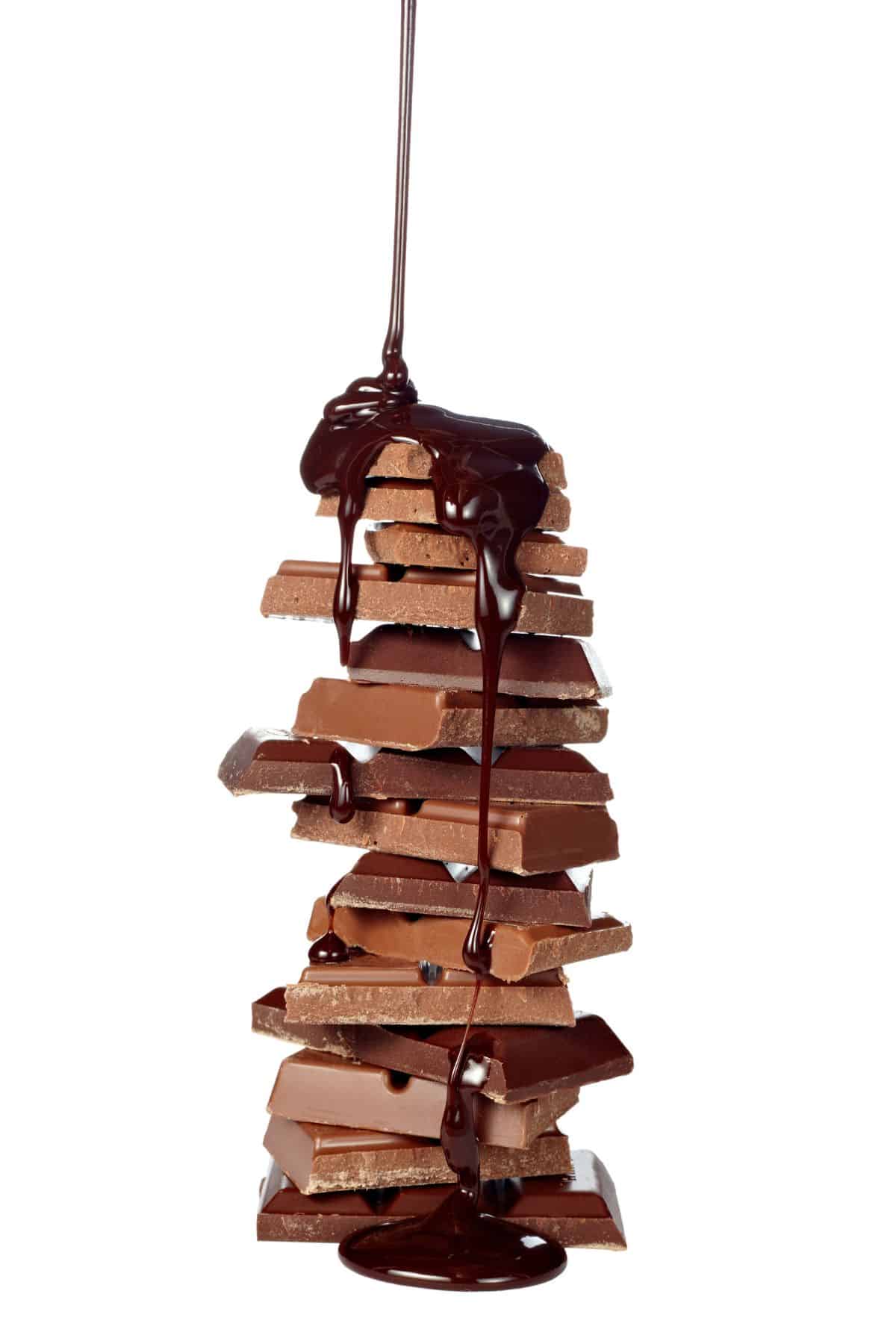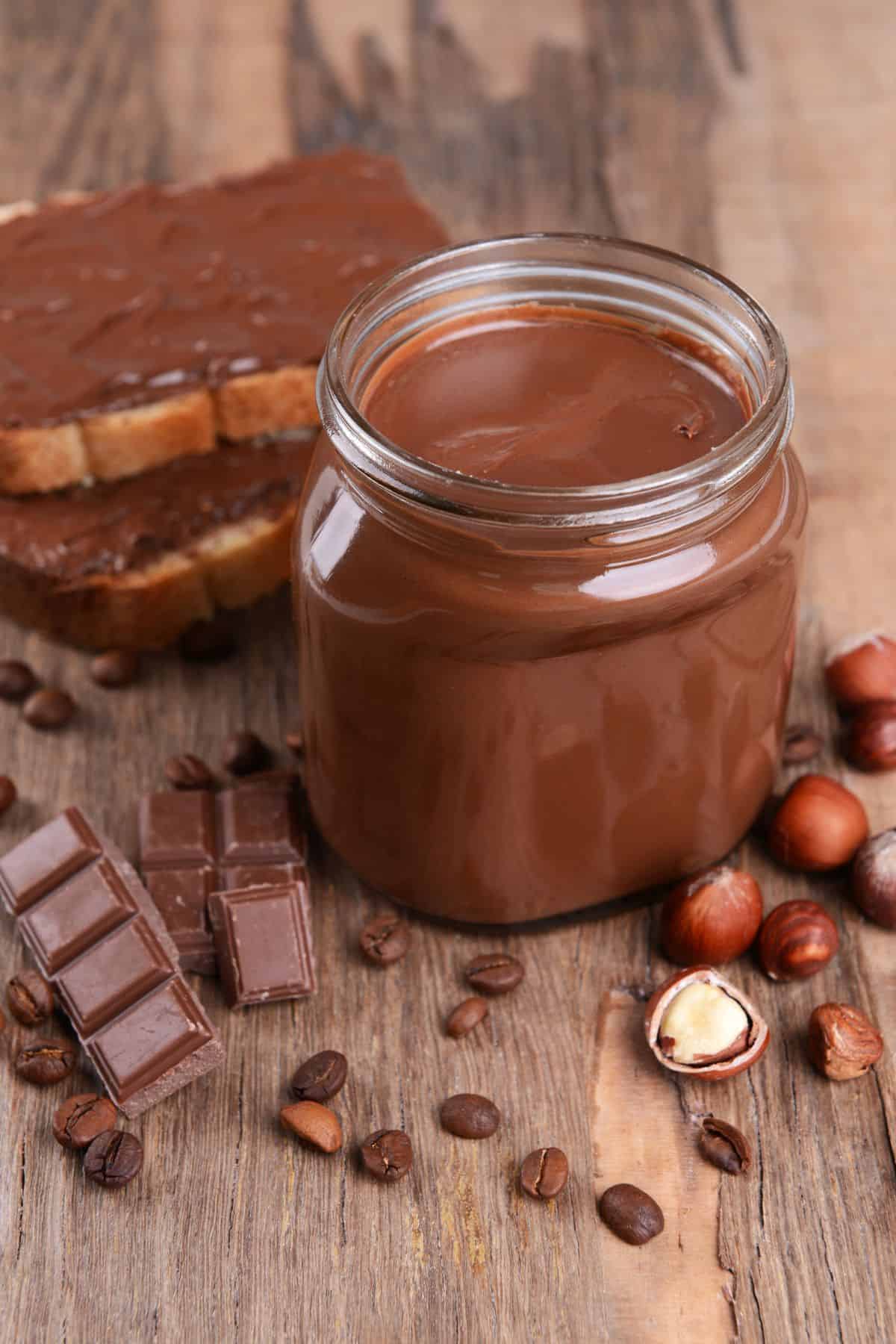If you find yourself in need of a cocoa powder substitute when whipping up your favorite chocolate cakes, chocolate chip cookies, or chocolate pastries, you're in luck. Not only does cocoa powder come with a long list of acceptable substitutes, but some even pack some health benefits! So read on because below I list several ways that you can substitute cocoa powder that taste just as great, as well as a few creative replacements you probably didn't think to use!

Jump to:
- What is cocoa powder?
- Types of cocoa powder
- What can I use instead of cocoa powder?
- 1. Raw Cacao Powder
- 2. Dutch Process Cocoa Powder
- 3. Carob Powder
- 4. Black Cocoa Powder
- 6. Unsweetened Baking Chocolate
- 7. Hot Cocoa Mix
- 8. Hot Chocolate Mix
- 9. Chocolate Chips
- 10. Dark Chocolate
- 11. Couverture Chocolate
- 12. Chocolate Malted Milk Powder
- 13. Chocolate Protein Powder
- 14. Chocolate Syrup
- 15. Espresso Powder
- 16. Nutella
- So what is the best cocoa powder substitute?
- Cocoa powder substitute FAQs
- The BEST Cocoa powder Substitute
What is cocoa powder?
Often used to add chocolate flavor to beverages, sauces, frostings, and baked desserts, cocoa powder is an unsweetened powder derived from the cacao bean. It is made by fermenting, roasting, and extracting the fat from cacao beans (also known as cocoa butter), which is then dried and ground into a powder.
Although it has a very rich chocolate flavor, cocoa powder on its own is very bitter and must be complemented with sugar or other sweeteners for the best flavor. Also, depending on what type of cocoa powder is used, the fat content and richness can vary quite a bit, with higher-end brands having higher fat content and flavor.
Types of cocoa powder
There are three main types of cocoa powder, all of which have different chemical components and acidity levels. The one you choose for your recipe can significantly affect its texture, rise, flavor, and color, so it is important to choose carefully:
Natural Cocoa Powder is the lightest and most commonly used cocoa powder. If a recipe calls for "cocoa powder," it is usually referring to natural cocoa powder. Often an ingredient in baked goods recipes such as cookies, brownies, cakes, and muffins, unsweetened natural cocoa powder has a bitter flavor that helps balance the sweetness in recipes. Because of its high acidity and bitterness, natural cocoa powder is usually found in recipes with baking soda. The baking soda, which contains alkaline, helps to neutralize its acidity and give it a milder flavor.
Dutch Process Cocoa Powder (also known as alkalized cocoa powder) is darker, less acidic, and less bitter than natural cocoa powder. It is made by washing cacao beans in an alkaline solution to neutralize the acidity, resulting in a smoother, milder, caramel-like flavor. Dutch process cocoa powder is usually found in recipes where baking powder and baking soda are also ingredients. When it comes to fat content, Dutch process cocoa powder is usually on the higher end.
In my recipes, whether it be brownies, cookies, or cakes, I almost always recommend using dutch process cocoa powder for a balanced taste, beautiful color and flavor.
Black Cocoa Powder is a type of unsweetened ultra-Dutch-processed cocoa powder that has been even further exposed to the alkalinizing process to reduce its acidity. Because of its dark color, it is often a natural food coloring agent for baked goods. However, it has low-fat content and is best alongside other cocoa powders to prevent dryness.
What can I use instead of cocoa powder?
There can be a few reasons you need to replace cocoa powder in your recipe: You may have an allergy or dislike the taste. Or maybe you've run out of your supply at home. Whatever the reason, there are several acceptable cocoa powder substitutes that you can use in its place:
- Raw Cacao Powder
- Dutch Process Cocoa Powder
- Carob Powder
- Black Cocoa Powder
- Unsweetened Baking Chocolate
- Hot Cocoa Mix
- Hot Chocolate Mix
- Chocolate Chips
- Dark Chocolate
- Couverture Chocolate
- Chocolate Malted Milk Powder
- Chocolate Protein Powder
- Chocolate Syrup
- Espresso Powder
- Nutella
1. Raw Cacao Powder
Raw cacao powder is the pure, unprocessed version of cocoa, straight from the cacao pod. Made from cold-pressed and unroasted cacao beans, it retains most of its nutritional value. However, it has a much bitter flavor than other cocoa products and may not immediately be pleasing to the palate.
Cacao powder is a good substitute for cocoa powder in cakes, brownies, and cookies. You can also use it to sweeten drinks or as a sprinkled topping on other sweet treats.
How to use it:
Because of its more potent flavor, it is not recommended to substitute cacao powder at a 1:1 ratio when baking. Instead, you will want to use a little less to reduce the bitter flavor. On the other hand, in raw dessert and drink recipes, it is OK to use it as a direct 1:1 substitute.
When using cacao powder as a cocoa powder replacement, use baking soda as a leavening agent to help reduce its acidity.
2. Dutch Process Cocoa Powder
Dutch processed cocoa powder has a darker color and more robust flavor than natural cocoa powder. It is commonly used in baking chocolate recipes that call for a rich chocolate flavor and it is my preferred cocoa powder overall. Dutch process cocoa powder is an easy substitute for cocoa powder in brownies, cake, and cookie recipes. It is what gives life to my Austrian sacher torte cake and triple chocolate cake recipes! You can also use it for chocolate drinks, frostings, ice cream, and savory dishes like chili.
How to use it:
Substitute dutch process cocoa powder for natural, unsweetened cocoa powder at a 1:1 ratio. You will want to use a combination of baking powder and baking soda to help it rise, reduce its acidity, and keep it moist and fluffy.
3. Carob Powder
Made from dried and roasted carob tree pods, carob powder is a popular and healthy low-fat cocoa powder substitute. Like natural cocoa powder, carob powder is often used as a natural sweetener. Its earthy, nutty flavor is milder and more bitter than natural cocoa powder, but its color is very similar.
Carob powder is often used as a cocoa substitute in baked and no-bake goods such as cake, brownies, cookies, fudge, and mousse. Because of its sweet and mild flavor, it is also great in recipes that don't require much sugar, such as pancakes, oatmeal, and ice cream shakes.
How to use it:
Carob powder is an easy 1:1 exchange for regular cocoa powder in any recipe. If you feel like increasing the chocolate flavor, you can always add more carob powder.

4. Black Cocoa Powder
Often used as a natural food coloring agent in chocolate desserts, black cocoa powder is an excellent cocoa powder substitute if having a smooth, dark color is more important than chocolate flavor. Using black cocoa powder alongside other cocoa powders is more common than using it alone.
When baking, black cocoa powder is a better substitute for other Dutch-process cocoa powders than natural cocoa powder. It is often found in recipes that require an almost black color, such as a themed Halloween cake or homemade Oreos.
How to use it:
Use black cocoa powder half-and-half alongside other cocoa powders for the best taste and texture.
Black cocoa powder does not react with baking soda to help baked goods rise, so if baking a cake or other dessert that rises, pay attention to the amount of cocoa powder needed. If the recipe calls for more than ¾ cup of cocoa powder, you'll also want to add 1-2 teaspoons of baking powder.
Because of its low-fat content, black cocoa powder can cause your baked goods to turn out dryer than other types of cocoa powder. Therefore, consider adding or increasing the high-fat content ingredients in your recipe.
6. Unsweetened Baking Chocolate
Made from cacao beans, 100% unsweetened baking chocolate contains cocoa solids and makes an excellent substitute for cocoa powder. There are also different varieties, such as bittersweet and semi-sweet, as well as milk and white chocolate. However, it may not be the best substitute if time is of the essence. Baking chocolate only comes in blocks or chips and must be melted before blending into your recipe.
Flavorwise, unsweetened baking chocolate won't have as much chocolate flavor as cocoa powder would. The texture may differ slightly from when using cocoa powder, but not enough to affect the recipe.
How to use it:
Use 40g / ¼ cup of baking chocolate for every 2 tablespoons of cocoa powder. You will first need to melt the baking chocolate over double boiler or microwave and stir it until no lumps are left. Then, blend it into your recipe when you add the sugar and butter.
7. Hot Cocoa Mix
Hot cocoa mix is a combination of unsweetened cocoa powder and sugar. While many brands are dairy-free, some brands may also include dried milk.
Since it is not a pure cocoa powder and contains other ingredients, hot cocoa mix is not ideal in baked goods requiring precise measurements or recipes with a rich chocolate flavor. However, it is an acceptable substitute in sugar-heavy recipes where the chocolate flavor and texture isn't as important.
How to use it:
For the best flavor, substitute hot cocoa mix for cocoa powder in a 2:1 ratio so if the recipe calls for 1 tablespoon cocoa powder, add 2 tablespoons of hot cocoa mix. Since hot cocoa mix already has quite a bit of sugar, it is best to add the cocoa mix before adding any other sweeteners to the recipe. Only add as much as it takes to achieve a desirable taste.

8. Hot Chocolate Mix
While similar to hot cocoa mix, hot chocolate mix is not the same. Hot chocolate mix is made with real chocolate and typically combined with a warm liquid such as milk, water, or creamer, resulting in a thicker texture and a richer chocolate flavor. If you have a chocolate bar, you can easily make hot chocolate at home by blending it with one of the mentioned liquids.
How to use it:
For each teaspoon of cocoa powder, substitute two teaspoons of hot chocolate mix. Since hot chocolate mix uses real chocolate with typically added sugar, it will taste more sweet than pure cocoa powder. Therefore, you may need to adjust the sugar used in the recipe to achieve a similar flavor.
9. Chocolate Chips
Chocolate chips can come in many flavors, as well as in both sweetened and unsweetened forms. To use it as a substitute for cocoa powder, you will need to pay close attention to whether it contains cocoa butter, sugar, or milk and how much it contains so that you can adjust the recipe accordingly. Unsweetened chocolate chips are the best choice for the flavor closest to that of cocoa powder.
Chocolate chips are best as a cocoa powder substitute in sweet treats such as pastries, cookies, brownies, cakes, pancakes, and pies.
How to use it:
Use ½ cup / 90g chocolate chips for every 3 tablespoons of cocoa powder. It may be helpful to melt or grind the chocolate chips into smaller pieces before adding them to your recipe.
Depending on what kind of chocolate chips you use may need to adjust the sugar levels to achieve the same taste. Both sweet chocolate chips and semisweet chocolate chips. You may also need to change the fat and amount of milk used to get the same texture. That said, it is best to add the chocolate chips first and then slowly incorporate the other ingredients.
10. Dark Chocolate
If you have a dark chocolate bar at home, you can easily use it as an unsweetened cocoa powder substitute. When it comes to flavor, the best dark chocolate bar substitute has a high percentage of cacao and a lower ratio of cocoa butter sugar.
How to use it:
Use ½ cup / 90g dark chocolate for every 3 tablespoons of cocoa powder.

11. Couverture Chocolate
Although not the best cocoa powder substitute, you can use couverture chocolate if you don't have other options available. Couverture chocolates are unsweetened cooking chocolate typically used to make candies, dips, and frostings (such as my creamy chocolate cremeux). I use Callebaut couverture chocolate in all my recipes which has a wonderful taste, and aroma and work perfectly in baking.
How to use it:
Use ½ cup / 90g couverte chocolate for every 3 tablespoons of cocoa powder.
12. Chocolate Malted Milk Powder
Chocolate malted milk powder (such as Nestle Milo, Ovaltine or Carnation Malted Milk) is another ingredient that isn't exactly an ideal substitute for cocoa powder. Still, it will work if you need something to boost the chocolate flavor of your recipe.
How to use it:
Add double the amount of chocolate malted milk powder than you would cocoa powder. Then, make adjustments as necessary to achieve the desired taste. Milo powder can be used to replace cocoa powder 2:1 so use double amount of Milo powder to achieve a similar cocoa taste and reduce the sugar in your recipe.
13. Chocolate Protein Powder
If you're on a healthy diet but still want that chocolate flavor in your recipe, chocolate protein powder may be the best substitute for cocoa powder. However, it contains artificial chocolate flavorings and low cocoa powder content, so it wouldn't be the best substitute if a natural, rich taste is what you need. When considering chocolate protein powder as a substitute for cocoa powder substitute, the simpler the recipe is, the better.
How to use it:
When replacing cocoa powder with chocolate protein powder, you can do so in a 1:1 ratio. However, combine it with stronger cocoa powder alternatives for the best taste. To get a similar texture and consistency as cocoa powder, you will need to adjust or add other ingredients to the recipe, such as more liquid or eggs.
14. Chocolate Syrup
While not ideal in terms of texture, chocolate syrup is another possible sweetened cocoa powder substitute in a pinch. The downside is that the typical store-bought chocolate syrups have many artificial flavors, sugars, and additives, taking away from the natural cacao taste that cocoa powder otherwise provides. Therefore, chocolate syrups with high cocoa content are the best substitutes for cocoa powder.
How to use it:
You can typically substitute cocoa powder 1:4 with chocolate syrup, so use 4x more chocolate syrup than cocoa powder, however, this can vary depending on the brand.
Since chocolate syrup is a very sweet liquid, you will need to reduce the amount of sugar and other ingredients in your recipe, such as the amount of flour or water required.

15. Espresso Powder
If the chocolate flavor is not crucial in your recipe, espresso powder may be an acceptable non-chocolate flavor substitute for cocoa powder. Like cocoa powder, espresso powder is acidic, has dark colors, and has a strong bitter taste.
The downside is that espresso powder contains a significant amount of caffeine, so it would not be suitable for recipes you will serve children.
How to use it:
Use ¼ to ½ of the espresso powder that you would cocoa powder in your recipe. However, since it has a robust and bitter taste, it is recommended that you perhaps add extra sugar.
16. Nutella
A popular ingredient in pantry cabinets, Nutella is another cocoa powder substitute option if chocolate flavor is optional to the recipe. Made with cocoa, sugar, palm oil, milk, and other artificial flavors, Nutella is a sweeter alternative to cocoa powder. However, the texture may turn out differently than cocoa powder because of its high-fat content.
Nutella comes packed with hazelnut flavor and is a great substitute when baking cakes, cookies, and brownies.
How to use it:
Use ¼ cup / 45g Nutella for every 3 tablespoons of cocoa powder. Since Nutella is much sweeter than cocoa powder, you will want to reduce the amount of sugar in your recipe.

So what is the best cocoa powder substitute?
Although there are several cocoa powder substitutes to choose from, there is no "one size fits all" when it comes to finding the best one. The substitute that works the best will significantly depend on the characteristics of what you plan to make: Its flavor, level of sweetness, color, texture, acidity level, and whether or not it needs to rise.
However, in baking recipes my recommendation would be one of the following: dutch process cocoa powder, carob powder, or hot cocoa mix. If the cocoa taste is less important and another flavor is acceptable, you cannot go wrong with espresso powder or Nutella.
You will also need to consider the other ingredients required to make that substitute as functional as possible. Therefore, you will want to think about each replacement carefully to determine which is the best for you and your recipe.
Cocoa powder substitute FAQs
No, although they are often mistaken for one another. Cocoa powder is a natural product that comes directly from the cacao bean. On the other hand, chocolate powder is a form of cocoa that has been processed with other ingredients.
Although great for baking, almond flour has an almond taste and does not resemble cocoa. Therefore, if a chocolate flavor is a must in your recipe, almond flour would not make a good substitute.
While flour has a similar texture as cocoa powder, I would not recommend it as a replacement if the chocolate color and flavor are essential to your recipe.
I do not recommend using chocolate pudding mix as it contains several other additives and can significantly affect the outcome of the recipe.
To retain the proper color and taste, it is best to stick to natural cocoa powder when making red velvet cake. You could use carob powder, dutch processed cocoa powder (with strong red gel food coloring) but I do not recommend using any other substitute.
Drinking chocolate is liquid and contains a whole bunch of ingredients from sugar, water, flavorings etc. so it is not the best substitute for cocoa powder in cakes and requires totally reformulating the recipe eg. adding less sugar and liquid etc.

The BEST Cocoa powder Substitute
Best substitutes for cocoa powder - Option 1.
- 1 tablespoon Dutch processed cocoa powder
Best substitutes for cocoa powder - Option 2.
- 1 tablespoon Carob powder
Best substitutes for cocoa powder - Option 3
- 2 tablespoon Hot cocoa mix reduce sugar from your recipe
Instructions
- Replace 1 tablespoon cocoa powder with either option 1 or 2 or 3
Note
-
- Raw cacao powder
- Black Cocoa Powder
- Unsweetened Baking Chocolate
- Hot Chocolate Mix
- Chocolate Chips
- Dark Chocolate
- Couverture Chocolate
- Chocolate Malted Milk Powder
- Chocolate Protein Powder
- Chocolate Syrup
- Espresso Powder
- Nutella


Leave a Reply